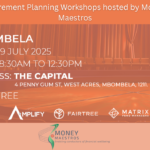I have been in the financial services profession since 2013 and my experience has taught me that clients have one central question they need help answering: “Am I going to be okay?” In the context of retirement planning, the capital available vs capital required calculation should be enough to answer this question. A surplus in the calculation would mean yes, you will probably be fine, and a shortfall means no, you’re not going to be completely okay. Simple.
I have found, however, that the longer I work as a financial planner, the more difficult this question is to answer. Even with a pretty cool tool that helps me illustrate the capital available vs capital required calculation. I guess that is the normal evolution of any vocation.
As a financial planner, I would’ve been better equipped to deal with this question if I had a psychology class in my commerce-based undergraduate and postgraduate studies. For the psychology students turned financial planners, we envy you. The answer to the question, I believe, requires the courage to leave your technical skills at the door.
Have you ever found yourself emotionally charged about a situation? Am I the only one who has mistakenly told my wife to calm down, when she wasn’t calm and then expected her to calm down? For context, we have two kids under the age of seven and some days it is like the Wild West in our house. I should know better.
A few years ago, I received an email from a client that accused me of missing, and thus not taking action on a crucial instruction. After reading and re-reading the client’s email and reviewing all our historic email correspondence (and to be safe, I also checked my WhatsApp chat history, my Facebook messages and even my Twitter DMs – fun fact, I had no DMs), I was able to confirm, thankfully, that I did, in fact, not miss their instruction. But from the email I read multiple times, the client was adamant that I made a mistake. The client even pointed out in their email that they remember telling me how important this new retirement annuity account with its monthly debit order was to them and that it was a top priority to implement.
After writing and rewriting my reply trying to absolve myself from the mistake that wasn’t mine, I re-read the client’s initial email and (finally) caught a glimpse of something more. Having reflected on this story more than a few times, I could have managed my emotional response better, I could’ve potentially picked up the distressed or panicked response from the client’s email sooner.
After a quick pep talk with my colleague and friend, Louis, we decided to phone the client instead of responding via email. And this was the best lesson I have ever learnt about the presentation of left-brain fact vs right-brain feeling. To cut a long story short, the client had just separated from their spouse, and they were starting their divorce proceedings. So, an email that I understood to be an accusation of my inability to execute the clearly expressed wishes of my client was a symptom of the root cause which, now with hindsight, was my client’s search for certainty, security and safety given that their world had just turned upside down.
I know this story might seem to have nothing to do with retirement planning or life after work, but honestly, it has everything and more to do with retirement planning. And let me tell you why. Retirement planning is an example of one of life’s many transitions and is not simply a discipline on its own. By only focusing on a client’s money during a transition – solely providing a retirement income funding plan for example – and not on the client’s life that is changing, we could miss an opportunity to provide our client with the much-needed certainty, security and safety they seek.
I’m sure you will agree that journeying with a client through any life transition, whether retirement or something else, can be uncomfortable. But I believe when you are feeling uncomfortable or out of your depth, that is where the magic happens. When you are not in the driver’s seat, it forces you to focus on your client and not on your ability to flex your technical financial planning muscles. This is key for your client’s life to be changed in the best way.
This approach to tackling a client’s transition into retirement (including any other transition) has been a game-changer for me. I believe it can significantly impact your planning process, business and most importantly your clients.
The framework we use when walking a client through a life transition, including that of retirement, is built around the following three key areas:
- Create a safe space
- Move to the balcony
- Give the work back
Creating a safe space
The essence of a safe space is that “during times of transition when the client is immersed in uncertainty and important aspects of their life are shifting, they need an anchor. They need someone they trust who tells them that what they are experiencing is normal. They need that person not to rush them or make them feel incompetent if they’re uncomfortable with the idea of a timeline for their work. They need to feel like they’re not ‘crazy’, that it is okay to feel ‘numb’, and they need to know that there isn’t some giant, life-altering decision that they might miss or mess up. And if there is a giant, life-altering decision to be made, they need to know that they will have help making it. They want what we all want during a tumultuous time: to feel safe and protected”.[1]
To become a safe space for a client, we must sharpen our emotional intelligence (EQ) skills to counteract our intelligence quotient (IQ), which at least for me is my (unfortunate) default mode. The work of Daniel Goleman in his theory of social intelligence helped me come to terms with the skills I needed to add to my toolkit to be the best financial planner for my clients. And these skills will improve your relationship with those closest to you too. Win-win. Goleman’s theory of social intelligence has two parts: social awareness and social facility. Social awareness is the ability to accurately notice the emotions of others and “read” situations appropriately. Social facility builds upon social awareness to allow smooth and effective interactions. Social awareness coupled with social facility (and a healthy dose of self-awareness) is one of the quickest and most authentic ways to build trust with someone.
And it should be no surprise that trust is the foundation upon which deep, lasting and impactful relationships are built. When working out your social awareness and social facility abilities, your humanity will be highlighted along with your technical skills.
Moving to the balcony
If you have successfully created a safe space for your clients, they will trust you enough to follow you as you move from the garden bench to the balcony overlooking the stunning garden with views as far as the eye can see. This analogy is all about perspective.
If you decide, based solely on your experience of sitting on the garden bench, you can easily make a wrong decision because what you can see from your seated position is limited. That said, you can also make a wrong decision based solely on your view from the balcony, as you would not consider what it is like to be in the garden. So with that in mind, managing the tension between being seated on the garden bench and viewing the garden from the balcony up high and the fluidity with which you move between the two, will be a skill that adds significant value to the financial planning process.
Giving the work back
As a financial planner, “giving the work back” was the most difficult part of adopting our new transitions-focused framework. It has also been the most liberating part. “Giving the work back” has allowed me to remove many unnecessary and unfair responsibilities I placed upon my shoulders in my client relationships. Is it fair that we are expected to take sole responsibility for creating the financial plan and adopting advice given within that financial plan?
By “giving the work back” we accept that “it is not our job to mysteriously solve our client’s problems and create a plan of action from behind a curtain”.[2] If we move from creators of our client’s financial plans to co-creators by “giving the work back” to them, they discover what they want, what they value most, what kind of life they want to lead and what kind of legacy they want to leave. By doing this we will, without a doubt, see our clients flourish as they move through their different transitions.
By walking alongside our clients, we will help them move towards living a life of significance. My clients, your clients, our clients will be able to do that because we’ve shown them that once the dust has settled, they will be okay. They might even reflect that something good has come out of the previous season of their life even though it was difficult. And that will help them move a bit lighter into their next season.

[1] Financial Transitionist Institute Core Training Course Curriculum
[2] Financial Transitionist Institute Core Training Course Curriculum










